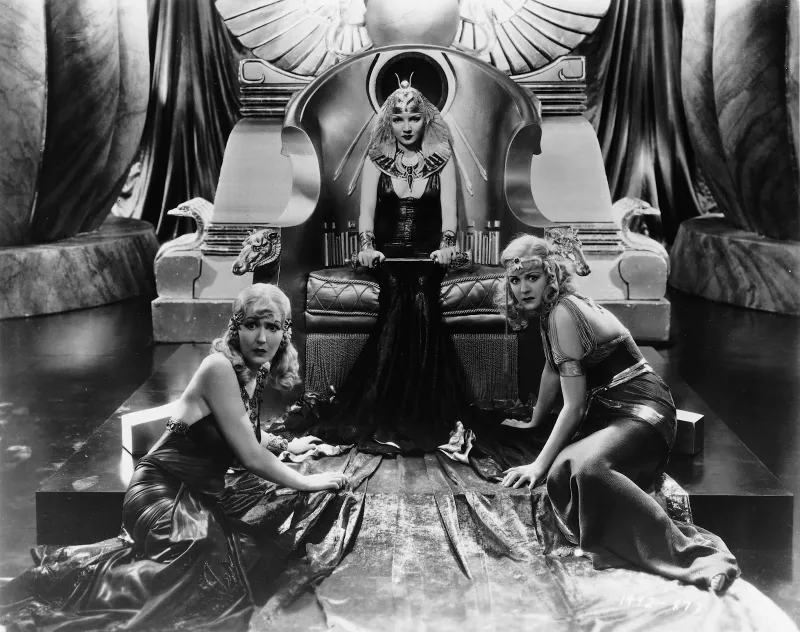“Cleopatra” is a sumptuous spectacle and a smorgasbord of schlock. In this 1934 film, director Cecil B. DeMille relates the oft-told tale of the last ruler of Egypt. She seduces the formidable Julius Caesar, but he is assassinated before she can become his queen. Cleopatra does not mourn him long, however, as she falls in love with Caesar’s confidant, Marc Antony. After watching “Cleopatra,” it’s not hard to see why Susan Sontag called DeMille a master of camp. In her essay “Notes on Camp,” Sontag asserted that “camp taste nourishes itself on the love that has gone into certain objects and personal styles.” Indeed, throughout the film, you can sense the love that DeMille has for this subject. You can also feel the effort Claudette Colbert exerts as she portrays the Egyptian queen. Together, DeMille and Colbert create a delightful film that forces us to examine the virtues of camp.
Camp is often defined as something which is so bad it’s good, and “Cleopatra” certainly has its flaws. The focal point of the film is the romance between Cleopatra and Marc Antony, but there is little chemistry between actors Claudette Colbert and Henry Wilcoxon. Colbert and Wilcoxon do not seem to have anything in common besides a mutual love of luxury and drink. We are supposed to believe that Cleopatra and Antony’s love is strong enough to result in the collapse of the Egyptian state and the end of Roman democracy. Yet, it seems that their passion would crumble if they spent one night together; here, the film falls dramatically flat. Given the circumstances of their chemistry, why should we care if Cleopatra and Antony’s love will survive? Furthermore, some of the dialogue is so hyperbolic that it distracts from the topic of conversation. For example, when Cleopatra asks why Antony has not tired of her and sought another woman, he responds “because you are another woman.” Even a 1934 Variety review noted, “often the lines drew titters that [were] not being angled for.”
Still, I wouldn’t go so far as to call “Cleopatra” a bad film, because DeMille has a clear vision for how to bring this story to the screen. Other directors might treat “Cleopatra” as a romance, but as evidenced by the pairing of Colbert and Wilcoxon, this is not DeMille’s approach. Other directors might see the story as a period piece. DeMille, however, decides to decorate Cleopatra’s throne room with anachronistic Art Deco designs. It looks more like the lobby of the Chrysler building than an Egyptian palace. Instead, DeMille treats “Cleopatra” as an exercise in excess. His directorial philosophy is that more is more, and so we see not just one but four peacocks strut out of Cleopatra’s chambers. When Antony summons his troops, he sounds the gong not just once, but multiple times. Sontag states that in all camp, you feel “the unity, the force of the person,” and DeMille’s sensibility comes through clearly here.
Colbert’s performance fits perfectly into DeMille’s mise-en-scene. Colbert is intensely expressive. When she declares her passion for Antony, we can see the emotion on her face. Her rage is palpable when she hears about attempts to destroy Egypt. She is constantly oscillating between pathos and comedy. As she overacts in her lustrous gowns, it is hard to take your eyes off of her. It’s not an understated performance, but in a film as extravagant as DeMille’s, there’s no reason why it should be subtle.
Some viewers might be disappointed that there is little underneath DeMille’s resplendent mise-en-scène and Colbert’s alluring performance. “Cleopatra” could be described as “gilded.” Yet, this lack of depth is not necessarily a flaw. On its original release, “Cleopatra” probably provided a welcome refuge from hardship. After all, if DeMille could mount such a lavish production in 1934, then surely America could rebound from this economic crisis. In its frivolity, “Cleopatra” provides a valuable insight into the Depression-era psyche.
Still, who cares about the human condition when you can see Claudette Colbert, donning dazzling dresses, lording over an Art Deco dominion? There are sequences in this film so grandiose and so bizarre that I cannot describe them. Besides, even if I could recount exactly how Cleopatra seduced Antony, I wouldn’t want to spoil the joy of seeing it on screen. For Sontag, camp was valuable simply because it provided an alternative to the vagaries of high culture. As she explained, “the man who insists on high and serious pleasures is depriving himself of pleasure; he continually restricts what he can enjoy.” Many of the men who wrote film history fit this description, and they made it seem as if all 1930s films were technically innovative tour-de-forces. “Cleopatra” corrects these lopsided chronicles by showing us that old films are not simply “high and serious pleasures.” Sometimes they are absurd and ostentatious, and to be a true cinephile, you have to take the canon along with the kitsch.
Contact Amir Abou-Jaoude at amir2 ‘at’ stanford.edu.
